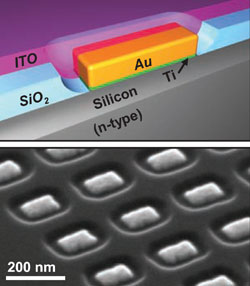Last month I did a rough cut and paste overview (using papers available via google scholar) on the topic of rectennas or nantennas finishing on the topic of the possible capture of infrared light for power generation. Now an article published last month in Science (Vol. 332 no. 6030 pp. 702-704 ) has demonstrated the capture of infrared radiation using nantennas constructed using silicon based semiconductors. While this is a significant advance, hold the champers. The fabricated device, while useful as a sensor, only converts ~0.01 % of the absorbed photons into a photocurrent over the wavelengths for which it is tuned. The authors suggest some methods to increase this to 2%. What is significant is that because it uses mature silicon technology devices could be fairly rapidly mass produced IF the overall performance can be increased.
It's not solar nanvarna yet but… stay tuned!
Photodetection with Active Optical Antennas (free pdf)
Mark W. Knight, Heidar Sobhani, Peter Nordlander and Naomi J. Halas
Nanoantennas are key optical components for light harvesting; photodiodes convert light into a current of electrons for photodetection. We show that these two distinct, independent functions can be combined into the same structure. Photons coupled into a metallic nanoantenna excite resonant plasmons, which decay into energetic, “hot” electrons injected over a potential barrier at the nanoantenna-semiconductor interface, resulting in a photocurrent. This dual-function structure is a highly compact, wavelength-resonant, and polarization-specific light detector, with a spectral response extending to energies well below the semiconductor band edge.
More coverage at the Royal Society of Chemistry.
There's something about the mention of hot electrons that gets the chemist in me a bit excited.

No comments:
Post a Comment